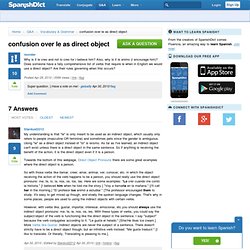

Confusion over le as direct object. My understanding is that "le" is only meant to be used as an indirect object, which usually only refers to people (masculine OR feminine) and sometimes pets since the gender is ambiguous.

Using "le" as a direct object instead of "lo" is leísmo. As far as I've learned, an indirect object can't exist unless there is a direct object in the same sentence. So if anything is receiving the benefit of the action, it is the direct object even if it is a person. Towards the bottom of this webpage, Direct Object Pronouns there are some great examples where the direct object is a person. So with those verbs like llamar, creer, amar, animar, ver, conocer, etc. in which the object receiving the action of the verb happens to be a person, you should really use the direct object pronouns: me, te, lo, la, nos, os, los, las.
However, with verbs like, gustar, importar, interesar, emocionar, etc.you should always use the indirect object pronouns: me, te, le, nos, os, les. Direct and Indirect Object Pronouns Used Together. Home / Grammar / Topic Notes: The written lesson is below.Links to quizzes, tests, etc. are to the left.

Here are the direct object pronouns and the indirect object pronouns side by side: When you have both a direct object pronoun and an indirect object pronoun in the same sentence, the indirect object pronoun comes first. Ellos me los dan. Whenever both pronouns begin with the letter "l" change the first pronoun to "se. " le lo = se lo le la = se la le los = se los le las = se las les lo = se lo les la = se la les los = se los les las = se las The reason for changing "le lo" to "se lo" is merely to avoid the tongue-twisting effect of two short consecutive words that begin with the letter "l".
In negative sentences, the negative word comes directly before the first pronoun. No se lo tengo. Because the pronoun se can have so many meanings, it is often helpful to clarify it by using a prepositional phrase. Él se lo dice. She should explain it to me.Ella me lo debe explicar.Ella debe explicármelo.
Spanish direct & indirect object pronouns. Now that you’ve learned about direct and indirect object pronouns, what happens if you want to use them together?

The sentences that follow are examples of both object pronouns being used together. The direct object is in bold, while the indirect object is underlined. • Does Hector give them to you? - ¿Te los da Héctor? • They ask us for it. - Ellos nos lo piden. • I need to give it to him tomorrow. - Necesito dárselo mañana. To refresh your memory, the direct and indirect object pronouns that you will use in combination are as follows: When you combine the direct and indirect object pronouns in a sentence, you have two options. • You can put the indirect object pronoun, followed by the direct object pronoun, as two separate words before the verb • You can attach the indirect object pronoun and the direct object pronoun onto the end of an infinitive (Note that you must add an accent on the infinitive ending to preserve the correct pronunciation.)
Por ejemplo: